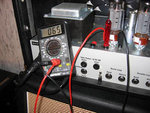duesentrieb
Well-known member

If you should use one of the tools which reads the cathode current you don't need to pull the fuse !
Install the adaptors between the tube(s) and socket(s), read your current on the tool and adjust the bias with a screwdriver that you stick into the black (!) hole. With a Bias-Tool you don't use either the red hole nor the black hole on the far right side.
Any more questions?
Now to the calculations:
Diezels biasing recommendations are for biasing reading the plate current - with bias tools you are reading the cathode current, which should be 5-10% higher than the plate current recommendations.
So instead of 30mA per tube (for EL34s) its 33mA
For the given range of 60-70mA per pair it is 66-77mA per pair - or 33 to 38.5mA.
Any more questions?
Here's a pic (using the DMM method - not with a bias tool) to show you where to put the screwdriver








